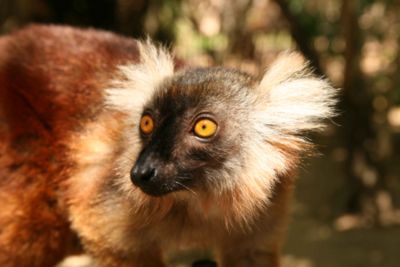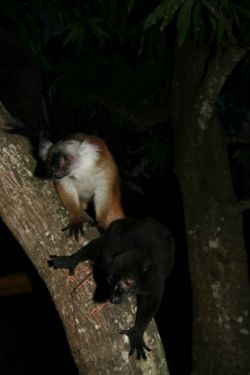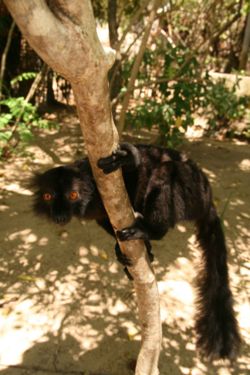Eulemur macaco (Black Lemur): Difference between revisions
imported>Kim van der Linde m (Black lemur moved to Eulemur macaco (Black Lemur): per naming convention) |
imported>Robert W King No edit summary |
||
| Line 1: | Line 1: | ||
{{ | {{subpages}} | ||
[[Image:blemur female.jpg|thumb|right|400px|A female '''black lemur''', (''Eulemur macaco macaco'').{{photo|Lee R. Berger}}]] | [[Image:blemur female.jpg|thumb|right|400px|A female '''black lemur''', (''Eulemur macaco macaco'').{{photo|Lee R. Berger}}]] | ||
Revision as of 12:40, 14 November 2007

The black lemur Eulemur macaco macaco, a so called "true lemur", is a medium-sized quadrupedal Lemur. In the wild, it is found only on the island of Madagascar and small islands of the Northeast coast.
Description
The black lemur is a cathemeral Primate that has a head body length of approximately 39 – 45 cm and a tail length of around 50-65 cm[1][2][3]. Weight ranges between approximately 3 and 3.5 kg[3]. Males are typically dark chocolate brown to black, while females have golden-brown to chesnut colored backs and light colored bellies. The female's face is grey to black, the crown a darker grey and the ears white tuffed [3]. The eyes of both sexes are orange [3].

Behaviour
The black lemur is highly adaptable to different habitats and group sizes range from 2 to 15 [3]. Females give birth to typically a single young usually between September and November[3].

Diet
It is highly frugiverous but also eats seeds, leaves and nectar [2][3].
Geographical distribution
The black lemur may be found in tropical moist lowland and montane forested areas of northwestern Madagascar and on islands around Nosy Be[3].
Status
The black lemur is considered to be endangered by the IUCN.